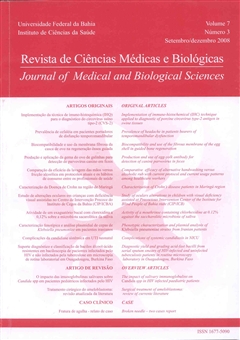Produção e aplicação da gema do ovo de galinhas para detecção de parvovírus canino em fezes
DOI:
https://doi.org/10.9771/cmbio.v7i3.4463Palabras clave:
Parvovírus canino- Diagnóstico -Anticorpos IgY - ELISA indireto, Parvovírus canino- Diagnóstico- HA-HIResumen
O parvovírus canino (CPV) pode causar uma doença intestinal caracterizada por diarréia sangüinolenta e muitas vezes fatal em filhotes. O vírus é transmitido pelo contato com cães infectados através das fezes. O vírus é muito estável no ambiente e pode sobreviver por vários meses em áreas contaminadas. O CPV infecta rapidamente as células da medula óssea e intestino delgado. Vários testes laboratoriais foram desenvolvidos e estão disponíveis para diagnóstico viral específico. O diagnóstico rápido pode ser feito por microscopia eletrônica (EM) do material fecal de casos com sinais típicos da doença. O vírus pode também ser isolado de caninos e felino e desenvolvidos em várias linhagens celulares, como células renais canina e felina, mas raramente é usada na prática, já que para culturas de células são necessárias pelo menos uma semana para obtenção dos resultados. A Hemaglutinação e inibição da hemaglutinação (HI-HA) são métodos simples e rápidos para a detecção do vírus em amostras fecais e de tecidos e são contratados por vários laboratórios de diagnóstico, porém, o teste de HA é menos sensível do que EM ou ensaios imunoenzimáticos (ELISA). Neste trabalho, imunizamos galinhas com a cepa Cornell 780916-80 do CPV, isolamos anticorpos policlonais IgY da gema de ovo, caracterizamos sua atividade biológica por ELISA indireto e western blotting. Posteriormente, foram detectados a presença de CPV nas fezes de animais suspeitos através do teste de ELISA indireto e com o teste de HA.Descargas
Los datos de descargas todavía no están disponibles.
Descargas
Publicado
2008-02-29
Cómo citar
Guimarães, M. C. C., Amaral, L. G., Borges, F. V., Vieira, H. P. L., Shimoya, A., Matta, C. G. F., & Matta, M. F. de R. (2008). Produção e aplicação da gema do ovo de galinhas para detecção de parvovírus canino em fezes. Revista De Ciências Médicas E Biológicas, 7(3), 241–248. https://doi.org/10.9771/cmbio.v7i3.4463
Número
Sección
Artigos originais
Licencia
A Revista de Ciências Médicas e Biológicas reserva-se todos os direitos autorais dos trabalhos publicados, inclusive de tradução, permitindo, entretanto, a sua posterior reprodução como transcrição, com a devida citação de fonte. O periódico tem acesso livre e gratuito.






